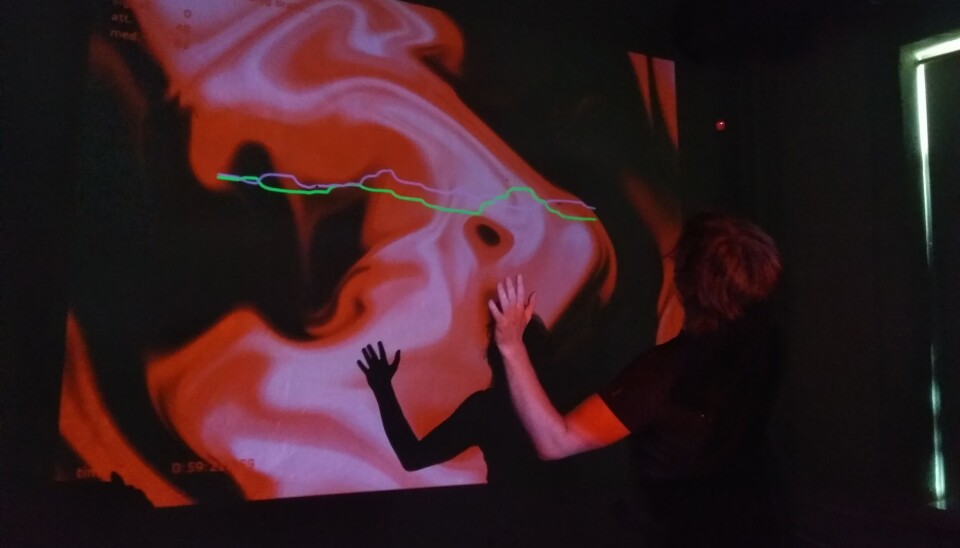Researchers' Zone:

New research lets us into the brains of artists
Ever wondered what goes on inside a performer’s brain? With EEG-technology we can show what the performing person feels in real time.
Have you ever been curious about what an artist feels on stage?
When a performance artist for example interacts with the photograph from her family archive, while telling the audience the story – what is really going on inside her brain?
With a little help from science, you can now experience the feelings of the performer in real time.
In this article I will tell you how such a tool works and how, by connecting EEG-technology and giving access to the inner feelings, the performer dives into closer empathic connection to the audiences.
For the audience it is also possible to trace the moments of excitement for the performer and what moments make the performer relaxed.
Thus, performance artwork enters the dimension of interpersonal connections between the performer and the audiences. Such interconnection enhances the experience for the audience.
EEG technology made useful to art
EEG technology measures electrical activity in the artist's brain. It can show delta, theta, alpha, beta, and gamma frequencies.
In my current research the data from alpha, beta and gamma waves was used, as these frequencies show relaxed and concentrated inner conditions.
When a performance artist wears an EEG device on his or her head, the data thus shows when the artist is relaxation and concentrated.
The custom prototype application was created for this project, which can provide live output or record and reconstruct the recorded EEG data.
The EEG data is presented to the audience in the real time visualized as interchanging colors in movement. Simultaneously it becomes the part of the scenography, creating an aesthetical experience for the audience.
Six years of brain wave art
Besides being a researcher I am also a performance artist myself, and have been active in the performance art field during the last twelve years.
I was wearing an EEG device during most of my performances, created in the period 2015-2021.
The EEG data for the audience was always presented by me during each of the performances. I explained how it is remediated into colors, graphs, or as sound, and what different colors, shapes or sounds mean.
So the audience could follow the changes in my inner conditions presented to them by me, verbally and by technology.
The current research is based on my own performance art projects, where one of those performances was the collaboration with the choreographer Kaspar Aus, while the other cases were my solo performances. One project is performed by another artist.
Curious audiences: ’I wonder what happens if …’
The real time experience gives the audience the authentic glance into the performer as a human being, who carries emotions and excitement. A human being, that reflects on the physical conditions while performing live artwork.
The audience reacts by the expressions of curiosity, often interacting with the performer to observe what would happen as the response to those interactions – will something change on the screen? Will there be an immediate change in the color, connected to the data from the brainwaves?

These findings can bring research and technology closer to art.
For example in the academic contexts, at the performance art education in the art academies.
When accessing information about past performances, students study the written descriptions of performances or look at video recordings or photographs.
Hopefully the findings of my current research would encourage the students to think towards the new possibilities. And expand the current findings by their own further explorations on how biometric data can change the ways of perception of the past performances.
A window into creativity
One of the main concluding points of my research is that EEG, used as biometric technology, can show to the audiences the connectedness between the excitement and creative moments of the artists. And also show the cognitive conditions during these moments within the live artwork.
Performance (as specifically the artistic media, containing the body of the performer) is different from the wide scope interactive art and design artworks, because of its presence only within the meeting with the audiences.
The artifacts after the performance can remain, but it's always something else than the actual performance. The performance can be attempted to be repeated - but it will always be a different artwork, never the exact same performance.
The the inner conditions of the performer during conducting such an artwork are always unique and dependent on how the audience will interact. On what questions will be posed, if the audience will touch the parts of performer’s body – maybe there will there be some emotional contact with the passersby?
EEG data allows us to see the exact bodily states during the exact performance artwork.
The research was conducted at The University of Lapland in Finland and was finalized during my position as a Visiting Researcher at Roskilde University. The PhD defense of the dissertation is on 4th November. Please contact mgriniuk@ulapland.fi for the Teams link if you are interested in joining the PhD defense digitally.
This article was originally published on our Danish sistersite, Forskerzonen.





